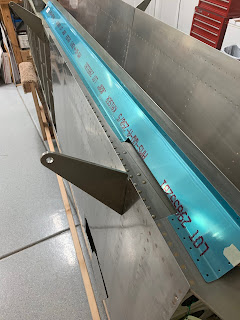I've seen several aircraft flying (including the Vans owned airplane) that didn't have any filler to blend the transition from fiberglass to aluminum. I got the idea from some other builders and we worked on this skill during the EAA course. My desire is to have a near flawless transition between the two materials in the empennage, mainly for aesthetics, and maybe the extra .1 knots of speed due to aerodynamic effects.
I elected to use Aeropoxy products for my fiberglass work, including Aeropoxy Light which is a great filler that works very well once it's cured. It sands very easily and smooths out nicely to provide a good base before primer. I used a fairly thick coating in some places and then worked it down until there were no gaps. It wasn't perfectly smooth in all places, but mainly due to slight imperfections in the glass or aluminum (e.g. waves/thickness).
I surfaced prep by sanding the aluminum and the fiberglass to ensure good bonding with the Aeropoxy. I masked off the ares that I didn't want the filler with electrical tape.
This is what it looks like after initial application of the Aeropoxy.
And after sanding. Very smooth.
The rudder required a lot of filler, including multiple layers. I also added quite a bit at the forward top portion to smooth the transition between the rudder and VS.
Elevators
The bottom of the rudder presented some new challenges. The main challenge being that the thickness of the fiberglass was thicker than where it met the aluminum. So I had to build a little more filler on the aluminum side to aid the transition. The second issue is that the bottom fairing on the rudder needs to be removable in order to maintain the tail position light. I used the electrical tape on the fairing itself to prevent filler from getting on that surface. I sanded everything with the fairing in place including the screws and am pretty happy with the results.
Here you can see where the fiberglass really sticks out above the surface of the rudder.









































































